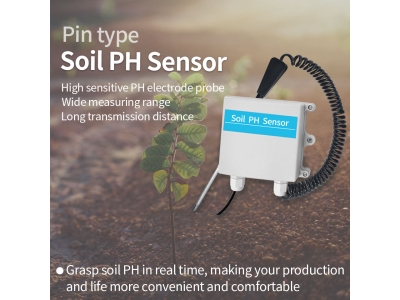Agriculture has been a crucial industry for centuries, providing food for the world's population. However, traditional farming practices are facing significant challenges, including climate change, water scarcity, and soil degradation. To overcome these challenges, farmers are turning to smart agriculture, also known as precision agriculture, which uses data to make informed decisions about planting, irrigation, fertilization, and other aspects of crop production. In this article, we will explore how smart soil sensor technology can help farmers to maximize crop yields.
What is Smart Soil Sensor Technology?

Smart soil sensor technology is a type of precision agriculture technology that uses sensors to collect data on soil moisture, temperature, and nutrient levels. The data collected by the sensors is then analyzed using algorithms to provide farmers with insights into the soil conditions. This approach can help farmers to make informed decisions about irrigation, fertilization, and other aspects of crop production.
How Smart Soil Sensor Technology Can Maximize Crop Yields
Smart soil sensor technology can help farmers to maximize crop yields in several ways:
Optimizing Irrigation: By collecting data on soil moisture levels, smart soil sensor technology can help farmers to optimize irrigation. This approach can ensure that crops receive the right amount of water, reducing water waste and improving crop yields.
Improving Fertilization: Smart soil sensor technology can help farmers to determine the nutrient levels in the soil, enabling them to apply the right amount of fertilizer. This approach can reduce fertilizer waste and improve soil health, leading to higher crop yields.
Identifying Soil Problems: Smart soil sensor technology can help farmers to identify soil problems, such as nutrient deficiencies or soil compaction. By addressing these problems, farmers can improve soil health and maximize crop yields.
Enhancing Crop Monitoring: Smart soil sensor technology can help farmers to monitor crop growth and health. By collecting data on crop growth and health, farmers can identify potential problems early and take corrective action, leading to higher crop yields.
The Benefits of Smart Soil Sensor Technology
Smart soil sensor technology offers several benefits for farmers, including:
Higher Crop Yields: By optimizing irrigation and fertilization, smart soil sensor technology can help farmers to achieve higher crop yields.
Reduced Input Costs: By reducing water and fertilizer waste, smart soil sensor technology can help farmers to reduce input costs.
Improved Soil Health: By identifying soil problems and addressing them, smart soil sensor technology can help farmers to improve soil health, leading to higher crop yields.
Increased Profitability: By maximizing crop yields and reducing input costs, smart soil sensor technology can increase profitability for farmers.
Challenges to Adoption
While smart soil sensor technology offers several benefits, there are challenges to its widespread adoption. One of the main challenges is the cost of the technology. Smart soil sensor technology can be expensive, making it inaccessible for many small-scale farmers. However, as technology becomes more affordable and accessible, the cost of smart soil sensor technology is likely to decrease.
Another challenge is the complexity of the data collected by smart soil sensors. Farmers need to have the knowledge and skills to interpret the data collected by smart soil sensors and make informed decisions based on the data. This requires training and education, which may be a barrier for some farmers.
Conclusion
Smart soil sensor technology can help farmers to maximize crop yields by optimizing irrigation, improving fertilization, identifying soil problems, and enhancing crop monitoring. This technology offers several benefits, including higher crop yields, reduced input costs, improved soil health, and increased profitability. While there are challenges to the widespread adoption of smart soil sensor technology, the future of agriculture looks promising as technology becomes more affordable and accessible.






